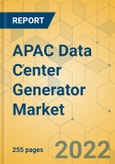Speak directly to the analyst to clarify any post sales queries you may have.
APAC data center generators market is expected to grow at a CAGR of 7.14% during 2022-2027
MARKET GROWTH ENABLERS
- Increase In Data Center Investments
- Increase In Power Outages
- Deployment Of Modular Data Centers & Gensets
MARKET SEGMENT ANALYSIS
In addition, Edge data centers with a capacity of < 1 MW will also boost the market for generators with a capacity of < 1 MW.
Fuel cell generators that are newly established in the market are carbon-free generators, reducing the adoption of diesel generators and competing with DRUPS systems during the forecast period.
Segmentation by System Capacity
- 0-1.5 MW,
- 5-3 MW
- More than 3 MW
Segmentation by System
- DRUPS
- Diesel/Gas/Bi-Fuel
Segmentation by Tier Standards
- Tier I & II
- Tier III
- Tier IV
GEOGRAPHICAL ANALYSIS
In China, data center investment is led by internet, cloud, and telecommunication service providers. In China, smart cities are also being developed, and therefore, the investments will rise in the region, for instance, Alibaba, a cloud service provider, has developed a smart city in Hangzhou called City Brain. In terms of investment, 21Vianet Group, GDS Services are the major investors in China which are followed by Chindata Group, Shanghai AtHub, and Tenglong Holdings Group in 2021. In terms of generator systems, a few examples are: Tencent data center facility in Ke Yun, China, is installed with 12 Kohler generator systems, and Equinix's Shanghai SH6 data center is installed with four MV Genset of 2,750 kVA and N+1 redundancy.
Segmentation by Geography
- China
- Hong Kong
- Australia
- New Zealand
- India
- Japan
- Taiwan
- South Korea
- Rest of APAC
- Southeast Asia
- Singapore
- Malaysia
- Thailand
- Indonesia
- Philippines
- Vietnam
- Other Southeast Asian Countries
VENDOR ANALYSIS
Vendors offering generator systems have a presence in multiple countries through local resellers and distribution networks. With data centers growing in capacity, the adoption of generators with a capacity of >2 MW is expected to continue to grow during the forecast period.
Key Vendors
- ABB
- Caterpillar
- Cummins
- Generac Power Systems
- HITEC Power Protection
- KOHLER
- Rolls-Royce
- Yanmar Holdings (HIMOINSA)
Other Prominent Vendors
- Aggreko
- Aksa Power Generation
- Atlas Copco
- DEUTZ
- Guangzhou Weineng Electromechanical
- HITZINGER
- Inmesol
- INNIO Group
- JCB
- Kirloskar Oil Engines (KOEL)
- Mitsubishi Heavy Industries
- ONIS VISA
- Perkins Engines
THE REPORT INCLUDES:
1. The analysis of APAC Data Center Generator market provides market size and growth rate for the forecast period 2022-2027.
2. It offers comprehensive insights into current industry trends, trend forecast, and growth drivers about the APAC Data Center Generator market.
3. The report provides the latest analysis of market share, growth drivers, challenges, and investment opportunities.
4. It offers a complete overview of market segments and the regional outlook of the APAC Data Center Generator market.
5. The report offers a detailed overview of the vendor landscape, competitive analysis, and critical market strategies to gain competitive advantage.
Table of Contents
Companies Mentioned
- ABB
- Caterpillar
- Cummins
- Generac Power Systems
- HITEC Power Protection
- KOHLER
- Rolls-Royce
- Yanmar Holdings (HIMOINSA)
- Aggreko
- Aksa Power Generation
- Atlas Copco
- DEUTZ
- Guangzhou Weineng Electromechanical
- HITZINGER
- Inmesol
- INNIO Group
- JCB
- Kirloskar Oil Engines (KOEL)
- Mitsubishi Heavy Industries
- ONIS VISA
- Perkins Engines
Methodology
Our research comprises a mix of primary and secondary research. The secondary research sources that are typically referred to include, but are not limited to, company websites, annual reports, financial reports, company pipeline charts, broker reports, investor presentations and SEC filings, journals and conferences, internal proprietary databases, news articles, press releases, and webcasts specific to the companies operating in any given market.
Primary research involves email interactions with the industry participants across major geographies. The participants who typically take part in such a process include, but are not limited to, CEOs, VPs, business development managers, market intelligence managers, and national sales managers. We primarily rely on internal research work and internal databases that we have populated over the years. We cross-verify our secondary research findings with the primary respondents participating in the study.

LOADING...








